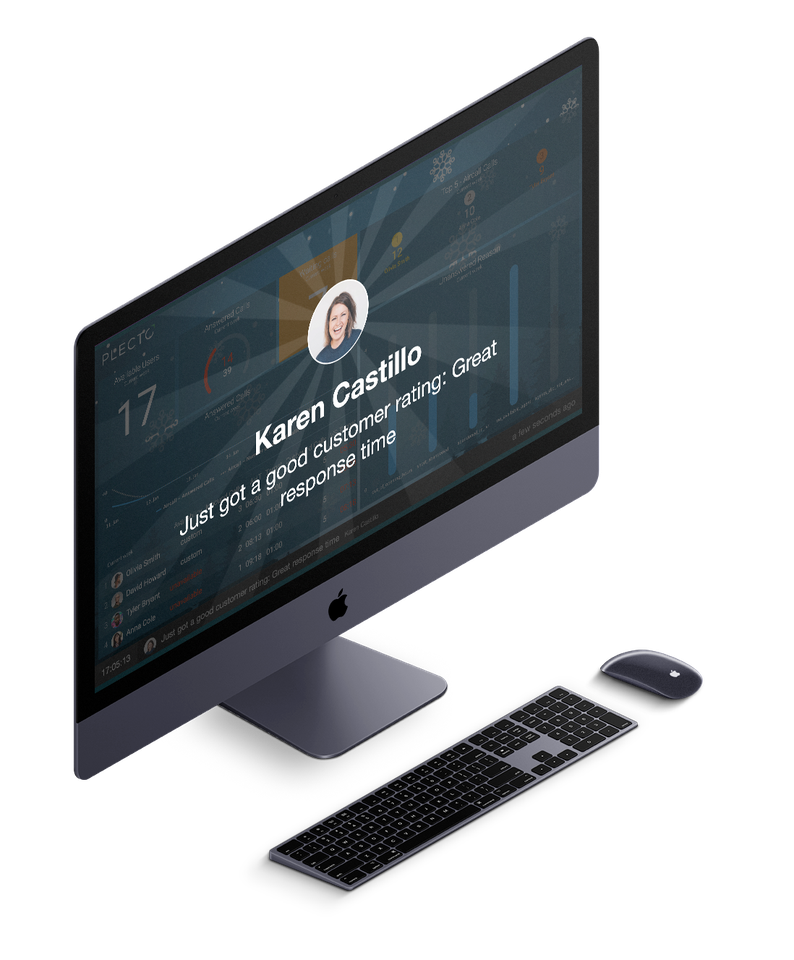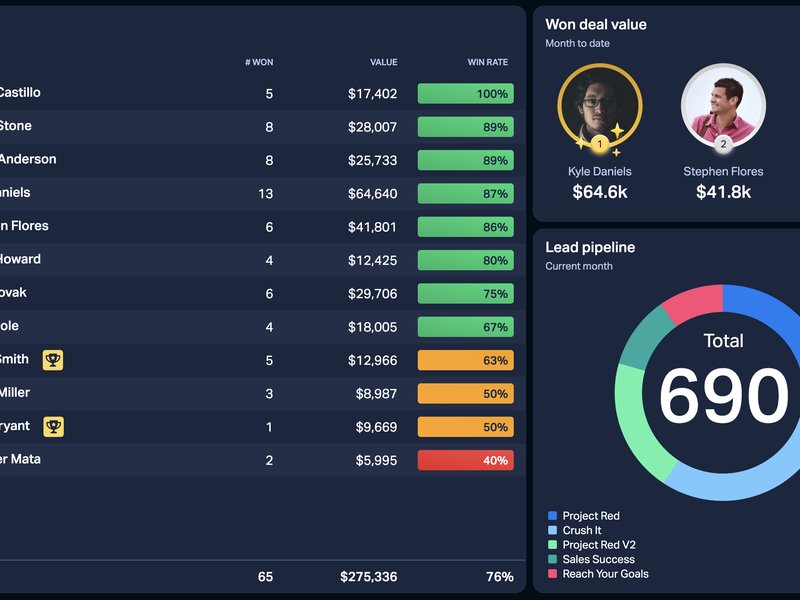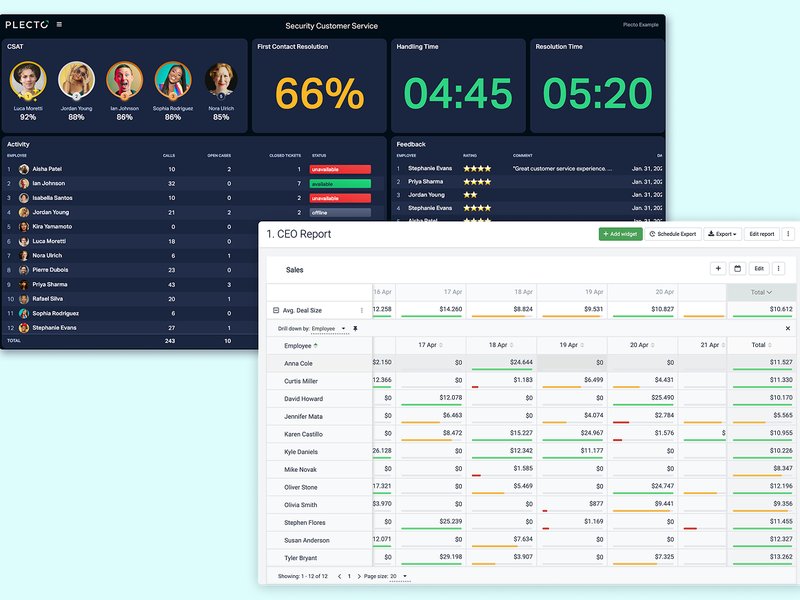Creating a CX dashboard from scratch can be daunting. In this article, we'll explain what they are and how they can help your business, the most critical things to consider when building one, and the best ways to monitor customer experience. We'll also take a quick look at how to monitor customer experience using Zendesk, and how to build an Intercom dashboard for customer success.
What is a customer experience dashboard?
Performance-driven companies are increasingly concerned about how their business looks in the eyes of their customers. Customer service dashboards or CX dashboards are becoming an increasingly essential tool for helping companies track customer service levels and overall customer satisfaction throughout the lifecycle from pre-sales to closing and beyond.
This information is particularly useful to the managers who are responsible for tracking the customer journey, managing customers' expectations, and resolving any issues that arise during interactions with their business. "Customer experience" is about much more than overall customer satisfaction. It's about understanding the whole customer journey, things like how customers interact with your company and whether they'd recommend it to their friends, family, and colleagues.
CX dashboards support companies in improving customer experience by enabling them to visualize CX data that might otherwise be buried in reports. This allows them to highlight key findings and actionable insights, which can spark collaboration and initiatives that have a huge impact on how customers perceive their experience with your business. Once you understand what matters most to your customers, and how you rank on those key metrics, you can identify key areas where you can improve.
A CX dashboard is a fantastic way to get a snapshot of what type of customer experience your company is delivering at any given time. It can give you a holistic overview of the relevant data in an easy-to-understand format that you can use to pinpoint parts of the customer journey that need improvement. Think of it as a roadmap that can help you prioritize your "must-win battles."
A well-planned customer service dashboard can raise awareness across your entire organization, highlighting the importance of the consumer experience, and how it contributes to your company's success. It can be an effective tool in driving the business decisions that will transform casual customers into brand advocates.

What should I consider when building a customer experience dashboard?
Before investing time and money in creating a CX dashboard, it's vital to do your homework. There's little doubt that giving your marketing team unfettered access to concrete customer experience insights can improve the success of their marketing efforts. However, failure to plan before you act can produce confusing, ineffective dashboards that aren't very helpful and result in lackluster performance. You must first understand your customer mix, business goals, and how these are related.
When planning your customer experience dashboard, it's a good idea to start at the end and design backward. Think about the business outcomes you're trying to achieve. How can data and metrics help you accomplish these goals? How can you make these data and metrics actionable? The best way to tackle this is to understand what each marketing employee needs to accomplish with the CX dashboard, and purpose-build it accordingly. Holding workshops with your marketing employees to gather business requirements is a great first step. The goal of these workshops should be to define a set of different user personas, which are mapped to the data and metrics they need to improve their marketing outcomes and performance. Don't forget to provide tools that will enable employees to provide feedback. This will be helpful in making incremental improvements that have a big impact on performance. You might also consider a soft launch, where selected marketing employees test drive your CX dashboard and give feedback before it's rolled out to the whole department. This can be helpful in securing employee buy-in, which in turn will improve your possibility for success.
Pay special attention to the business requirements of marketing employees who are directly responsible for the customer experience. These employees are likely to want data and metrics that help them measure satisfaction throughout the customer journey. While top-level management might want year-to-date data, a customer experience manager might need daily or weekly updates to assess campaign performance. Therefore, the business requirements for your CX dashboard should include segmented customer experience metrics at every stage of the customer journey. This data is invaluable in understanding how the customer experience can impact brand perception over time. Common business goals are essential to improving the customer experience and informing future marketing initiatives. Make sure to define the frequency of reporting.
In the end, the main reason you're considering investing in a customer experience dashboard is to improve your revenue. Therefore, it's important to align your CX dashboard with your overall business strategy and desired business outcomes. A well-planned and well-designed customer experience dashboard will provide actionable insights that enable you to make informed decisions that will advance your business.
CX dashboards are only effective if the data and metrics they provide are accurate and easy to understand. A customer experience dashboard that provides poor quality data that's difficult to interpret isn't helpful to anyone. Make sure to include contextual information like data sources, when the data was last refreshed, adequate labels, and any annotations that might be helpful to the users who are looking at the dashboard.
Be especially careful when aggregating data and metrics from multiple systems. One of the biggest potential pitfalls to selling in a new customer experience dashboard is doubt about data integrity. It's inevitable that from time to time, it'll be necessary to investigate a data anomaly. In these situations, it's best to avoid copying data out of the dashboard and into Excel for closer scrutiny because this creates multiple versions of the same data in different places. Instead, ensure that your CX dashboard embeds all supporting data into the rich data visualization experience or includes a sub-dashboard that includes the required information.
Don't forget to consider predictive analysis when designing your customer experience dashboard. Effective marketing doesn't rely solely on past trends. Predicting future customer behavior can drive proactive campaigns that can have a measurable effect on the business.
While customer experience dashboards are a powerful tool, they're not without potential risks. Proceed with caution when turning metrics into targets. This can easily send the wrong message and prompt numbers-driven business decisions that aren't necessarily focused on the customer experience. Clear targets are critical, but users must first understand the metrics, buy into them, and understand what actions they can take to influence them. Only then should the targets be communicated. Otherwise, you're potentially putting the cart before the horse and increasing the potential of becoming less customer-centric instead of more customer-focused. Make sure to promote a corporate culture that's driven by providing
outstanding service at every touchpoint in the customer journey, not just by improving efficiency based on data.
How do you monitor customer experience?
Monitoring customer experience and capturing insights you can use is both an art and a science. Customer service metrics can help you assess the impact of your company's customer service initiatives and identify areas in need of improvement, but how do you know what to track? How can you be sure that you're getting a holistic picture of the customer experience?
Following are five metrics you can use to glean actionable insights into how customers experience your business. However, how you react to insights you collect is a far more accurate predictor of your company's future success than the chosen metrics themselves.
- Net Promoter Score
Net promoter score or NPS is an excellent place to start. It's simple, relatively accurate, and it's the most commonly used customer experience metric. It uses one survey question to measure customer loyalty: On a scale of 1 to 10, how likely are you to recommend this company/service/product to a friend or colleague? NPS is an effective tool to quickly determine which percentage of your customers love, are indifferent to, or dissatisfied with your business. The insights you glean from NPS should align with data you collect about customer loyalty, engagement, satisfaction, and churn rate. - Customer Journey Analytics
Before you can improve the customer journey, it's crucial to understand your customers' experiences with your company. A customer journey map and touchpoint audit are logical places to start. Create a visual representation of the process a customer goes through in their interaction with your company. What are their motivations, needs, and pain points? List all of the touchpoints customers have along their journeys with your company.
Once you've identified this key information, you can collect the appropriate analytics. Consider things like your company's contact center, website, ads, social media platforms, product reviews, and emails. Establish metrics for each touchpoint, start collecting data, and you'll soon have an in-depth understanding of the customer journey experience with your company. Are there any gaps? What are you doing well? Where is there room for improvement? - Surveys
Sometimes, the best way to find out what you want to know is simply to ask.
Once you've identified your customer touchpoints, identify where it could be beneficial to send out surveys. These don't have to be in-depth. In fact, the shorter they are, the higher the response rate will be. One of the most effective ways of monitoring customer experience is by measuring the customer satisfaction score (CSAT) for each point in the customer journey. To do this, send out a one-question (similar to NPS) that asks: On a scale of 1 to 5, how satisfied were you with your recent experience (or goods/services you received)? This will give you immediate and actionable feedback on what you're doing well and where you could improve.
While NPS and CSAT are excellent tools for taking a quick measurement of customer satisfaction, they can't provide the same comprehensive level of insights as a longer survey. Not all surveys have to focus on NPS. You can also send out surveys that ask more in-depth questions about how customers perceive your company, product, and services; or solicit input on future products and services. Why not go straight to the horse's mouth? Just make sure not to overdo it by asking too many questions too often. - Churn Rate & Customer Retention
Where there's smoke, there's usually fire. Churn rate refers to the percentage of customers who stop doing business with your company over a specific period. Generally, if customers are having an enjoyable experience, they're going to keep coming back. Losing customers is part of doing business, but it's imperative to understand why it's happening. Once you understand "why," you can look into ways of stopping similar customers from leaving in the future. A hard look at this data might also lead to actionable insights that can help improve the overall customer experience.
Customer retention is the flipside of churn rate. Knowing how many customers do repeat business with your company is an important counterweight, and it can be a helpful reality check when trying to understand whether you're doing more things "right" than "wrong." - Customer Support Inquiries
Looking into why your customers are contacting support can help you identify trends and gaps in your service. Recurring performance issues with your company's products or services might eventually lead to a higher churn rate. These issues are often low-hanging fruit that can be efficiently addressed via instructional videos, clearer directions, or slight product modifications.
You might also find valuable insights by analyzing metrics related to things like response time, first contact resolution, number of contacts before resolution, and average time resolution.
Measuring Customer Experience with Zendesk
Zendesk has become an incredibly popular customer service platform because of its ability to help companies provide outstanding customer support across channels via web, email, phone, SMS, and social media. It also includes integrated tools that help identify important trends, ways to improve customer support, and measure customer satisfaction with your brand.
Zendesk makes it easy to assess and react to your company's most critical customer satisfaction-related data, for example:
- Support tickets and ticket status
- First response time
- First contact resolution rate
- Average resolution time
- Support tickets by type
- Support tickets by channel
- Top agents
- Utilization rate
- NPS
With Zendesk, you can easily track CSAT scores to help identify which channels have the highest customer satisfaction and shortest resolution times, so you'll know where to invest your time and resources.
Plecto is the perfect tool to help you get the most out of your Zendesk investment. Plecto integrates with Zendesk "out of the box" so you can quickly and easily build customized dashboards with the data that's most important to your business. You can import your data directly from Zendesk Support into a Plecto digital dashboard and visualize your business metrics and KPIs in real time. Now your support team can check ticket status, customer satisfaction, and more to consistently provide amazing customer service.
Learn more about how Plecto can integrate with Zendesk to improve your operations.
How to Build an Intercom Dashboard for Customer Success
Intercom is another effective digital tool in the arsenal of growth-minded companies. Like Zendesk, it allows customers to interact with companies across a variety of channels. Intercom collects analytics that support three main objectives: customer acquisition, customer success, and customer support. But this data is only helpful if you can access it and act on it, which is why dashboards are so necessary.
Plecto is an outstanding choice to help you dig deep into your Intercom data to find the insights that can drive customer satisfaction and your business to the next level. An integration between Intercom and Plecto makes it easy to create customized digital dashboards that add value to your Intercom data with meaningful visualizations that can be further customized using widgets. Add conditional colors to highlight progress toward important goals. Plecto's built-in gamification features, like leaderboards, encourage friendly competition to spark motivation among your employees!
Learn more about the types of data you can import from Intercom, and how Plecto can integrate with Intercom to drive loyalty and growth at every stage of your customer lifecycle.



